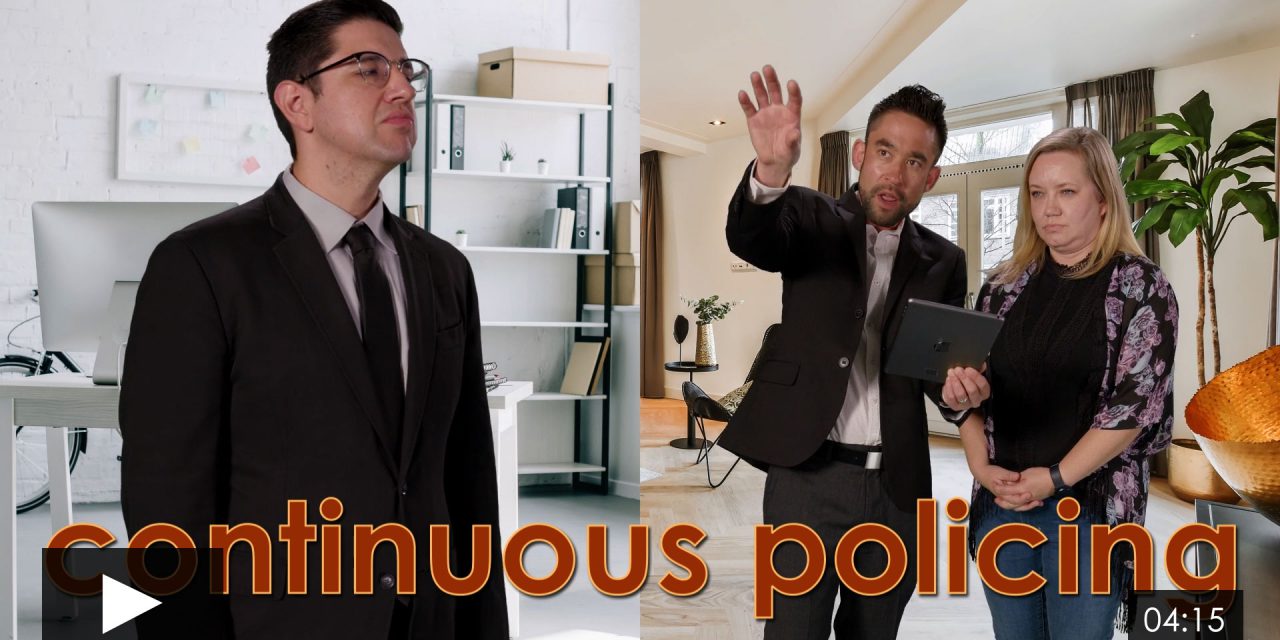This is the first episode in our new video series covering Risk Management principles. This episode delves into a broker’s exposure to liability caused by an error, omission or misunderstanding brought about by the activities of the broker or their agents.
Inherent risk
Brokers and agents interact amongst themselves and with members of the public. When acting under their California Department of Real Estate (DRE) licenses, brokers and agents act in the capacity of:
- an advisor to an individual who has retained the services of a broker to assist in a real estate related transaction; or
- an agent dealing with another broker, their agents or a member of the public in an effort to find a match for the individual they represent regarding ownership, financing or the letting of real estate.
These two relationships contain inherent risks. The risk of causing another person a loss is inherent in all activities conducted in the context of agency relationships.
Agency relationships exist as either:
- special fiduciary duties owed to the client; or
- general duties which are owed to the other party, called the customer.
The risks taken by a broker and their agents expose the broker to liability caused by an:
- error;
- omission; or
- misunderstanding brought about by the activities of the broker or their agents.
All acts carried out by a broker or their agents present the possibility that a client or other party will be injured financially. This includes investigations, inspections, negotiations, the giving of advice, and the preparation of disclosures and contracts.
It is the risk of causing these losses which the broker needs to control. Risks are best limited by choosing activities which can be conducted with more certainty of a favorable result when relied on by the client or other person in a real estate transaction. Thus, brokers need to maintain a risk reduction program to keep claims from clients and others under control.
Components of a risk reduction program
The five steps necessary to establish a risk reduction program are as follows:
- All activities exposing the broker to liability are identified based on whether the activity runs the risk of causing the client or others to be injured financially.
- Each identified activity is broken down into its component parts, i.e., all of the acts and events that comprise the activity, which need to be properly performed to eliminate the risk of causing a loss to a client, others or the broker.
- An evaluation is undertaken into what sorts of loss the client, others or the broker may experience if the broker or their agents undertake the identified activity, or a modified or alternative version of the activity.
- Brokerage activities are chosen and procedures and limitations adopted to control the parameters of the agent’s conduct when performing those activities, based on whether they provide the level of exposure to liability acceptable to the broker.
- Agent compliance with activities authorized and limited by the broker’s policies and procedures are tracked, and ongoing remedial training and dispute resolution for claims made by clients and others are established.
Identify activities requiring management
To initiate an analysis for managing the risk of loss, a broker needs to identify and list all the activities agents perform which could potentially be the source of a claim of liability against the broker.
Also, the nature of the services offered by brokers varies by whether the activities are classified as:
- the sale of single family residences (SFRs), income property or land;
- the financing of purchases, construction or equity; or
- the leasing or management of residential or commercial property.
Other categories of broker activity are based on their duty owed to the client for the performance of services sought by the client. This includes the actions of a seller’s broker, such as:
- advising the seller;
- inspecting the listed property;
- collecting data for disclosures;
- marketing the property; and
- negotiating the terms of a sale.
Likewise included are the actions of a buyer’s broker, such as:
- selecting qualifying property;
- gathering property information;
- confirming the veracity of seller disclosures;
- evaluating the data collected;
- advising the buyer; and
- negotiating acquisitions.
Mortgage broker and leasing agent activities likewise have categories of duties owed to the participants in their real estate transactions.
Other risks of exposure to liability arise out of losses incurred by clients and others when they rely on information provided by their broker but received by the broker from other sources, such as the property owner or third-party inspectors.
The uncertainties in each activity
After identifying the type of broker and agent activities which expose the broker to liability, the next step is to break down each activity into all of its essential parts. This process narrows down the acts containing uncertain results that may lead to the client suffering a loss.
The broker needs to determine what it is about a particular activity that could expose the broker to liability or other adverse consequences. This question is to be considered when defining the handling of an activity, such as a diligent visual inspection of property, the preparation of the Transfer Disclosure Statement (TDS) or review of an Annual Property Operating Data (APOD) sheet. This break down of the identified activity into its component parts becomes the checklist of proper and improper conduct. [See RPI Form 304 and 352]
Thus, a client or other person’s risk of loss is mitigated or averted completely.
For example, one of the activities to be identified in the first step of a risk reduction program is the giving of an opinion in response to an inquiry regarding a property.
Many aspects exist in developing and giving an opinion. The failure to consider each aspect creates exposure to liability. Thus, you need a checklist of actions to take regarding the process for the agent’s development of an opinion.
Related video:
Activities creating risk
Excessive market conditions, manifested by the boom and bust phases of the real estate business cycle, produce dangerous aberrations in the conduct of agents when dealing with buyers and sellers.
The activities of negotiating purchase agreements and obtaining new listings are acceptable brokerage activities. However, risky actions are occasionally incorporated into an otherwise appropriate activity. These can expose the seller to loss and the broker to liability. Listing and escrow arrangements, while routine and customary, are also to be evaluated for risk.
For example, agents often do not advise sellers that property disclosures are mandated to be delivered to prospective buyers as soon as possible after the prospect first seeks further information about the property. Likewise, seller’s agents improperly present adverse information about a property to the buyer at the last minute – well after a binding purchase agreement exists, escrow is open and the buyer has arranged financing.
Nondisclosure before entry into a purchase agreement creates an ambiguity about the property’s conditions, and thus the proper price to pay. This conduct exposes brokers to liability when the buyer experiences lost expectations of value.
Other components of an identified activity also evaluated for risk of loss include:
- What is the source of information given to a client?
- How credible is the source of the information?
- When is due diligence information-gathering activity undertaken?
- What is the proper time for releasing known information to prospects?
- What readily available information needs to be obtained and reviewed for unknown (but knowable) property facts?
- What other decisions may produce adverse consequences while performing the identified activity?
Having created a list of brokerage activities and actions a broker’s agents will be engaged in, an assessment is then conducted of the adverse consequences the activities might generate which may cause a loss for the client or others.
If it is determined a loss may occur, the significance of the loss needs to be evaluated to determine its financial impact on the client or other person – and whether the broker is exposed to liability for the loss. The evaluation process interprets, in terms of probable losses and liability arising out of an error or omission, the impact of risks taken when representing a client.
This evaluation precedes any decision by the employing broker to authorize an activity. Only after the evaluation can a broker logically undertake the risk of their agents performing the service for clients and others.
E & O insurance mitigates risk
As a buffer against liability, a broker can purchase negligence insurance, called errors and omissions (E&O) insurance. With the payment of a premium, E&O insurance protects brokers from the full cost of defending against a negligence claim made by a client or others. Similarly, auto insurance can be purchased to cover liabilities resulting from the agent’s use of their vehicle to conduct activities within the scope of the brokerage activities chosen and authorized by the broker for the agent to undertake.
Through both forms of insurance, the liability exposure for professional negligence and the cost of defense are shifted to corporate insurers willing to take on the financial burden of those uncertainties.
Avoiding acceptable levels of conflict
Even with insurance, each broker hiring agents needs to determine what level of risk is acceptable for them when undertaking a chosen brokerage activity.
For example, risks in providing information to clients and others may only result in minimal liability exposure for claims. These are absorbable risks the broker and their agents can take which are either uninsured or within the range of the deductible not paid by the insurer. When brokers authorize absorbable-risk conduct, an agent needs to agree to contribute to any settlement paid out by the broker on claims generated by the agent’s conduct.
However, some conduct in the performance of agency duties are pure risks which need to be avoided since they lead to absolute liability as entirely unacceptable acts. Pure risks include:
- deceit;
- withholding known or unknown but readily available information; or
- misstating or permitting the misstatement of facts or consequences of facts which cause the person relying on the statements to suffer a financial loss.
Substandard activity, sometimes called a classified risk, needs to be given special emphasis. This activity generally leads to a lack of proper performance. Occasionally it is the activity itself which is considered improper and automatically imposes liability for any losses it may cause.
Each broker hiring agents will have a different level of acceptable risk they are comfortable with. Whatever that level may be, policy measures need to be adopted to provide guidelines and instructions on just what steps agents are to take when conducting a brokerage activity chosen by the broker as an acceptable risk.
For example, trust funds need to be explained so the agent can identify them. Further, agents need to understand proper handling of an agent’s receipt, recording, safekeeping and delivery to the intended recipients and the agent’s timely performance of each step. Trust fund procedures need to be laid out in clear, concise language to avoid risks from mishandling. DRE audits may be the biggest risk of all.
Related article:
The management by the agent of a purchase agreement, deposit, disclosures and the dictating of escrow instructions needs to be detailed so the expectation of the agent about their conduct is well understood.
Tracking agent compliance with policy
Without an administrative structure to verify the broker’s agents are conducting themselves as intended, the broker will be exposed to an unnecessary risk of loss. Thus, continued oversight and policing are put in place to limit unilateral changes, distortions and deviations from agent conduct acceptable to the broker.
Oversight requires the commitment of financial and human resources to report unacceptable conduct, the holding of training meetings, and the maintenance of client files.
In a word: continuing management.














